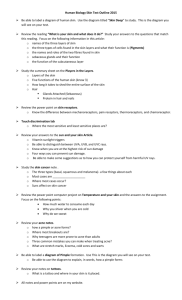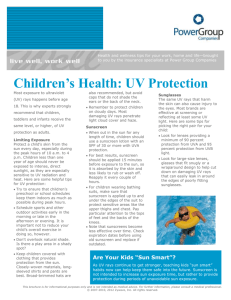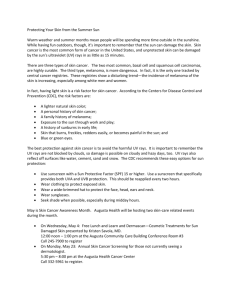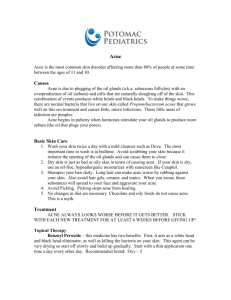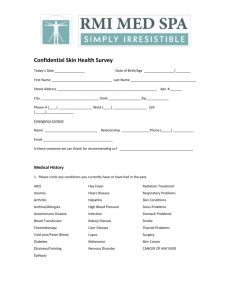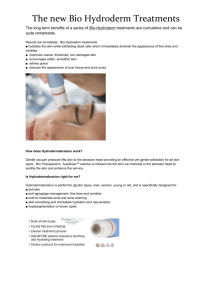Module 20: Skin Diseases and Disorders
advertisement
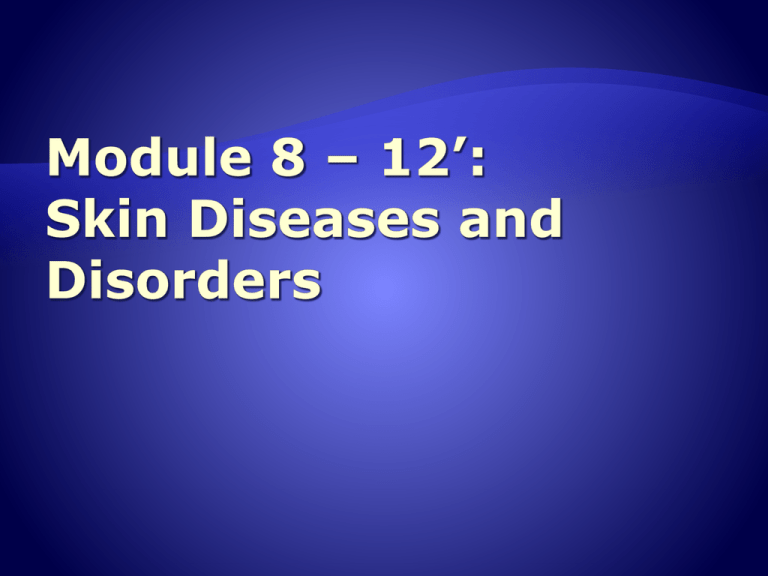
Skin care begins with understanding its underlying structure and basic needs You must recognize adverse conditions Inflamed skin Diseases Infectious skin disorders Skin care specialists are in high demand High end salons/spas Work less arduous and physically demanding Process that takes many years Do not necessarily age as your parents Genetic aging How your parents aged Their skin coloring Resistance to sun damage Gravity Facial expressions Repeated movements – expression lines Crow’s feet – eyes Nasolabial folds – corners of the nose Scowl lines – between eyes Primarily environmental factors Up to 85% of skin aging What we choose to put into our bodies has a profound effect on the over all aging process Sun Exposure Tanning= no-no Daily doses – damaging causing # 1 cause of premature aging Use broad spectrum sunscreen every day – (most makeup has) Smoking Free Radicals – unstable molecules that cause biochemical aging Causes premature wrinkling of the skin Weakening and contractions of the blood vessels and small capillaries Tissues are deprived of essential oxygen Skin may have a yellow or gray tone to it and a dullness Alcohol Causes body to repair itself poorly Interferes with proper nutrition distribution for skin & body tissues Over dilates the blood vessels and capillaries Causes capillaries to weaken and burst Flushed appearance and blotchy red eyes Dehydrates the skin by drawing out essential water Causing the skin to appear dull and dry Combination can be devastating to the skin Constant dilation and contraction of capillaries and blood vessels as well as oxygen and water deprivation quickly make skin appear lifeless and dull Difficult for skin to adjust and repair itself Illegal drug use Similar effects of smoking Interfere with body’s intake of oxygen – affecting healthy cell growth Some can aggravate skin conditions – acne Dryness and allergic reactions on skin surface Cumulative stress – Causes biochemical changes that lead to tissue damage Poor nutrition – deprives skin of proteins, fats, carbohydrates, vitamins, minerals needed Exposure to pollution – produces free radicals and interferes with oxygen consumption Outside factors that influence aging Sun Environment Health habits General lifestyle Heredity has little to do with the aging process when above factors are so great (15%) The sun and its UV rays have the greatest impact 80 – 85 % of our aging process is caused by the rays Collagen and elastin fibers weaken as we age Happens faster when skin is frequently exposed “Aging rays” 90 – 95% rays reach the earth Rays weaken the collagen and elastin fibers Causes wrinkling and sagging in skin tissues “Burning” rays Affects the melanocytes Rays can destroy melanocytes cells so they can no longer protect the skin Do not penetrate as deep as UVA rays Can be equally damaging to the skin and eyes UVB rays do contribute to the body’s absorption of vitamin D UVB rays - cause Sunburns Tanning Majority of skin cancers Shorter rays that penetrate at the base of epidermis Sunscreen of SPF 15 or higher Avoid exposure during peak hours (10 am – 3 pm) Apply sunscreen 30 minutes before exposure to allow for absorption Reapply sunscreen after water activity and sweating Sunscreen should be full or broad spectrum to filter both UVA & UVB rays – check expiration dates Avoid exposure for children under 6 months Wear protective clothing See Dermatologist regularly if changes in moles Coloration Size shape Self-care examinations Air pollutants affect the overall appearance and health Factories Auto exhaust Secondhand smoke Speeds up the aging process Follow daily skin routine Washing Exfoliating - Removes dead skin cells Moisturizers Protective lotions Foundation Objective symptoms Symptoms that can be seen Subjective symptoms Symptoms that are those that can be felt Prognosis Foretelling of probable course of a disease Diagnosis Recognition of a disease by its symptoms Dermatitis Venerate – allergies developed to ingredients in: Cosmetics Antiseptics Cold waving lotions aniline derivative tints WEAR GLOVES !!!!!!!!!!!!!!!!!!!!!!!!!!!!!!!!!!!!!!!! An inflammation of the skin caused by contact with chemicals or substances Develops an allergy to an ingredients or a chemical by repeated skin contact Sensitization – An allergic reaction created by repeated exposure to a chemical or substance Fingers Face scalp When irritating substances temporarily damage the epidermis Not usually chronic if precautions are taken Corrosive substances or exfoliants Inflammation, redness, swelling , itching, burning WEAR GLOVES!!!!! Or use tongs!!!!!! Hand washing causes dryness and cracking – use moisturizers Keep implements and surfaces clean and disinfected Wear gloves Keep hands clean and moisturized You must be prepared to recognize certain skin conditions Know what you can and cannot work on If you see a skin condition you do not recognize – refer to a physician DO NOT serve a client who has an inflamed skin disorder Lesion – is a mark that may indicate an injury or damage that changes the structure of tissues or organs Primary Secondary Tertiary Different color or raised above surface Bulla – A large blister containing a watery fluid Cyst – A closed, abnormally developed sac, containing fluid, semifluid or morbid matter Macule – A spot or discoloration on the skin – freckle Nodule – a solid lump larger than .4 inches, can be easily felt Papule – A pimple, contains no fluid but may develop pus Pustule – An inflamed pimple containing pus Tubercle – An abnormal rounded, solid lump Tumor – A swelling; an abnormal cell mass resulting from excessive multiplication of cells, varies in size, shape and color Vesicle – A small blister or sac containing clear fluid – Ex: poison ivy , poison oak Wheal – An itchy swollen lesion that lasts only a few hours Ex: insect bite, urticaria (skin allergy), hives, mosquito bite Those that develop in the later stages of disease: Crust - Dead cells that form over a wound or blemish while it is healing Ex: scab on a sore Excoriation – A skin sore or abrasion produced by scratching or scraping Ex: brush burn Fissure – A crack in the skin Ex: chapped lips or hands Keloid – A thick scar Scale – Thin plate of epidermal flakes, dry or oily Ex: dandruff Scar – Cicatrix – Light colored, slightly raised mark formed after an injury or lesion of the skin has healed Ulcer – An open lesion on the skin or mucous membrane of the body, accompanied by pus and loss of skin depth Open Comedo/Comedone – Blackhead – a wormlike mass of hardened sebum in a hair follicle – keratin and sebum T-zone Sebum exposed to environment, oxidizes and turn black Closed Comedo Milia – Whiteheads Should be removed under sterile conditions using proper extraction procedures Milia – Whiteheads – benign, keratin filled small, whitish, pear-like masses in/under the epidermis due to retention of sebum associated with fine-textures, dry skin types Sesame seed –round Eyes, cheeks, forehead Acne – A skin disorder characterized by chronic inflammation of the sebaceous glands from retained secretions, bacteria – Propionbacterium acnes Two Types Simple Acne Acne Vulgaris Sebaceous Cyst – large protruding pocket-like lesion filled with sebum Scalp, back Surgically removed Seborrheic dermatitis – skin condition caused by an inflammation of the sebaceous gland Redness, dry or oily scaling, crusting, itchiness Eyebrows, beard, scalp, middle forehead, sides of nose Cortisone creams, antifungal medications Rosacea – (formerly - Acne Rosacea) is a chronic congestion appearing primarily on the cheeks and nose Characterized by – redness, dilation of the blood vessels and the formation of papules and pustules Cause unknown Aggravated by: spicy foods, caffeine, alcohol, exposure to extremes of heat and cold or sunlight, and stress Asteatosis – Is a condition of dry, scaly skin due to a deficiency or absence of sebum, caused by old age and exposure to cold Steatoma – (Wen) Is a sebaceous cyst or fatty tumor, filled with sebum and ranges in size from a pea to an orange Usually appears on the back, neck or scalp Anhidrosis – Deficiency in perspiration Result of a fever or certain skin diseases Requires medical attention Bromhidrosis – Foul smelling perspiration Usually more noticeable in armpits and feet Hyperhidrosis – Excessive sweating Cause by: heat or general body weakness Medical attention is required Miliaria Rubra – Prickly heat – heat rash Characterized by: eruption of small red vesicles and accompanied by burning, itching skin Caused by: exposure to excessive heat Dermatitis – Inflammatory condition of the skin Eczema – An inflammatory, painful itching disease of the skin Forms: dry or moist Must be referred to a physician Cause unknown Not contagious Conjunctivitis Pinkeye Bacterial infection of the eyes Products or implements touching infected eyes MUST be thrown away Herpes Simplex – Fever blister or cold sore; recurring viral infection Characterized by: eruption of a single vesicle or group of vesicles on a red swollen base Lips, nostrils, other parts of face IT IS CONTAGIOUS! Virus remains in person’s body! Impetigo Contagious bacterial infection Weeping lesions Face (chin area) Children VERY CONTAGIOUS!!!!!!! Psoriasis – A skin disease characterized by: red patches, covered with white-silver scales usually found on the scalp elbows, knees, chest and lower back It is not contagious Caused by cells turning over faster than normal Irritated – bleeding can occur Not curable Albinism – Congenital leukoderma/hypopigmentation or absence of melanin pigment of the body Silky hair is white Skin is pinkish white and will not tan Eyes are pink Skin is sensitive to light and ages early Dyschromias – Abnormal colorations Accompany a skin disorder may mean systemic disorder Hyperpigmentation Darker than normal pigmentation Hypopigmentation Absence of pigment Results in white or light splotches Chloasma – increased pigmentation on the skin (not elevated) Also called moth patches or liver spots Cumulative sun exposure exfoliation Lentigines – singular: Lentigo – Technical term for freckles developed by exposure to sunlight and air Leukoderma – light abnormal patches Caused by: burn or congenital disease that destroys pigment producing cells Classified as : Vitiligo and albinism Nevus – birthmark Stain – Abnormal brown or winecolored skin discoloration with a circular and irregular shape – cause is unknown Tan – Change in pigmentation of skin caused by exposure to the sun or ultraviolet rays Vitiligo – Milky-white spots – Causes hypopigmented spots and blotches must be protected from overexposure to the sun (Michael Jackson claimed to have this) Keratoma – An acquired superficial growth of the skin – many are benign or harmless Callus Corn – inward growth Mole – A small brownish spot or blemish on the skin Any change in a mole requires medical attention Skin Tag – Small brown or flesh colored outgrowth of the skin Verruca – Wart – Caused by a virus Is infectious Can spread from one location to another Hypertrophy – abnormal growth of the skin Basal Cell Carcinoma – Most common and least severe characterized by: light or pearly nodules Squamus Cell Carcinoma – More serious, characterized by: red, scaly, papules or nodules Malignant Melanoma – Most serious Characterized by: black or brown patches on the skin, that may appear uneven in texture, jagged or raised Most commonly located on areas of the body not receiving regular sun exposure Least common, but most serious • Important for cosmetologists to be able to recognize the appearance of serious disorders to better serve clients • Cosmetologist should not attempt to diagnose a skin disorder, but should sensitively suggest the client seek medical advise from a dermatologist A – Asymmetry B – Border C – Color D – Diameter E - Evolving www.cancer.org Most people have skin care issues at some point in their lives Acne is both a disorder an esthetics issue Acne is a disorder affected by 2 major factors Heredity hormones Retention Hyperkeratosis Heredity tendency for acne-prone skin to retain dead skin cells in the follicle Forming an obstruction Exacerbates inflammatory acne lesions Papules & Pustules Skin oiliness is heredity Propionibacterium acnes are anaerobic Bacteria that cannot survive in the presence oxygen Main food source is fatty acids found in sebum Bacteria flourish in clogged follicle No oxygen Plenty of food (sebum) Bacteria multiply Causing inflammation and swelling Eventually rupture Immune system is altered Blood rushes to ruptured follicle with white blood cells to fight bacteria Causes redness in pimples Acne pustule is an inflammatory lesion resulting from wall rupture and infusion of blood Pustule forms from papule when enough white blood cells form pus Dead white blood cells Use cleaners formulated for oily skin Follicle exfoliants - leave-on products to remove cell buildup Allows oxygen in to kill bacteria Avoid products that contain fatty materials Noncomedogenic – designed and proven to not clog pores/follicles Do not use harsh products – can cause inflammation and worsen condition Trained salon and spa professionals can work over mild to moderate cases of acne – specialized education Rhytidectomy – face lift Blepharoplasty – Eyelid surgery Chemical Peeling – Specially formulated chemical solution is applied to the areas to be treated A technique for improving the appearance when wrinkles of the skin are present. The chemical causes a mild, controlled burn of the skin Rhinoplasty – Plastic surgery of the nose Mentoplasty – Chin surgery Dermabrasion – A technique to smooth scared skin by “sanding” irregularities Performed with a rotary abrasive instrument that thins the skin, making the sharp edges of facial scars less prominent Micro-dermabrasion – uses a diamond bit to “sand” off skin – “for younger looking skin” Injectable fillers – tiny injections of collagen may used to raise depressions closer to normal skin level Used for deep scars, acne scaring, deep aging lines around the mouth or forehead Ex: Botox
